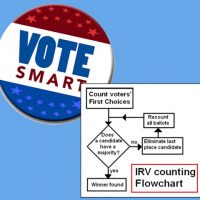Truth To Tell (2010-10-11)
Stand by for another minority governor. Short of a landslide for one of the three major-party candidates for governor, the winner will take office in January having been elected by a minority – or a plurality – of those voting in the November 2nd election. This will be third governor in a row taking office with a majority of ballots cast for someone else. Hardly a mandate to govern, and yet, with the unusual level of power vested in Minnesota’s governor, Jesse Ventura and Tim Pawlenty wielded the authority only a majority of voters should have elected.
In 1998, Ventura was elected with 37% of the vote, which when altered to reflect the 60% turnout that year (high, but serious contests draw voters), means Ventura was elected with about 22% of the eligible electorate. Now, even 51% of 60% is just about 31% – not a proud moment for Minnesota voters, but 51% remains a majority – far more representative of the people than 37%. In turn, Pawlenty was elected with just over 44% of the vote in 2002 and just under 48% in 2006. Third party candidates – no matter what their vote totals – helped determine the winner by siphoning off votes destined for the other two – often called a spoiler.
This year, three parties square off again and almost assuredly, Minnesota will have yet another minority governor. Mark Dayton (DFL), Tom Emmer (GOP) and Tom Horner (IP) are vying for the office and all the polls thus far point to a winner garnering less than a majority of the vote.
Does this mean we should do away with third (or fourth or fifth) parties? Certainly not. Multi-party elections are far more reflective of the electorate than trying to squeeze all others into narrow definitions of two parties. Horner’s competitive position proves this.
But minority victors are not representative, either, and so a system has come along to inexpensively determine a majority winner by allowing voters a second and third choice on their ballots: Ranked Choice Voting (or Instant Runoff Voting, if you will) is already in use in Minneapolis (and many other cities) and comes to St. Paul in their next election. City elections are nonpartisan and so RCV replaces the local primary, whereas in state-based partisan elections, the primary still selects the party nominees and the General is where RCV would be applied to multi-party ballots.
Perhaps predictably, the one entity just about unanimously opposed to such a change is the party most recently the beneficiary of the current plurality system – the Republicans. But DFLers, Independence Party members and Greens, among others, support ranked choice voting for statewide and local partisan elections.
This week, TruthToTell talks to prominent supporters and a detractor of RCV to lay out the pros and cons. Your humble servant has never concealed his support for the RCV remedy to achieve a majority victor in all races, so we don’t pretend to be entirely objective in Monday’s presentation of the issue. Still, the state’s most prominent opponent of RCV will join us by telephone.
Join TTT’s ANDY DRISCOLL and LYNNELL MICKELSEN for this important conversation less than a month before the November election.
ELIZABETH GLIDDEN – Minneapolis City Councilmember, Ward 8
TIM PENNY – 2002 Independence Party Candidate for Governor; former 1st District DFL Congressman; President/CEO, Southern Minnesota Initiative Foundation
WY SPANO – Director, Master of Advocacy and Political Leadership, University of Minnesota Duluth
JEANNE MASSEY – President, FairVote/Minnesota
ANDY CILEK – President, Minnesota Voters Alliance



